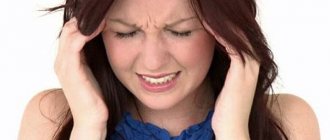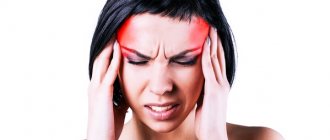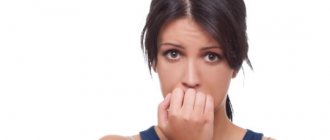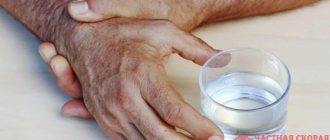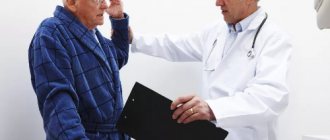Head tremors are rhythmic, involuntary rocking and oscillations of the head. They can be directed from side to side or back and forth. Tremor is diagnosed in people of any age category, including infants.
Specialists at the Yusupov Hospital take an integrated approach to the problem of treating head tremor after conducting a competent diagnosis and examination of each patient.
Causes of head tremors
Cervical dystonia
A characteristic sign of cervical muscular dystonia associated with impaired neck muscle tone is isolated head tremor. It occurs when maintaining a stationary position or at the beginning of a motor act (postural-kinetic), has a frequency below 7 Hz and varying amplitude. In some patients, tremors are present at rest. Dystonic tremor intensifies when turning and tilting the head in the direction opposite to the affected muscles. The patient's performance of reverse movements or corrective gestures (touching the chin) leads to the disappearance of trembling.
Essential tremor
Among the causes of head tremor, one of the main places is occupied by the essential process. Benign tremors, the mechanism of which remains unknown, can begin at any age. The disease debuts with tremors of the hands, the head is involved later. Symmetrical trembling with essential tremor is postural in nature or increases during movement, especially at its end point (terminal). Head tremors intensify with excitement and take the form of nodding (“yes-yes”) or rocking (“no-no”) movements.
The tremor frequency varies from 6 to 10 Hz in different patients. Over time, a resting tremor may develop, which is especially pronounced in a sitting position, but does not disappear with the onset of movement, being a continuation of the postural one. Other neurological disorders in essential tremor are usually absent, sometimes minor symptoms of ataxia, plastic hypertonicity (the “jackknife” phenomenon), and weakened facial expressions are observed. Some patients are diagnosed with mild cognitive impairment.
Parkinsonism
Classic parkinsonian tremor is a tremors at rest when the muscles are completely relaxed. Its source is recognized as the central oscillators in the basal ganglia. The neck muscles are involved simultaneously with the arms or a little later. Parkinson's disease is characterized by a “yes-yes” or “no-no” head tremor that disappears with movement. The picture is complemented by slowness, a shuffling gait, and a “supplicant pose.” Muscle tone changes (the “gear wheel” symptom), and the cognitive sphere suffers.
Multiple sclerosis
Tremor is considered a typical and common symptom of multiple sclerosis. Usually it is bibrachial, that is, it affects adjacent segments - one or both arms and the head. Trembling is explained by damage to the cerebellum and its connections, therefore it usually has an intentional nature, occurs during movement and intensifies when a goal is achieved. But people with multiple sclerosis may also experience other types of it, for example, head tremors at rest, caused by the presence of a focus of demyelination in the thalamus, basal ganglia or frontal lobes.
Multiple sclerosis, accompanied by tremors, has a number of clinical features. It is characterized by an earlier onset and a predominance of cerebellar disorders at the onset. The advanced stage of the pathology is manifested by imbalance in the form of static and dynamic ataxia, and oculomotor disorders. Pyramid symptoms (muscle weakness, spasticity) and sensory disorders are much less pronounced.
Metabolic encephalopathies
As a symptom of metabolic disorders, head tremor is included in the picture of generalized trembling hyperkinesis, involving the muscles of the arms, neck and torso. It is observed at the stage of subcompensation and progresses as the brain is damaged. Hypoxic-ischemic perinatal encephalopathy in children is caused by complicated pregnancy and childbirth (asphyxia, intrauterine infections, injuries). It can manifest itself as low-amplitude tremors, pathological head positions, clonic convulsions, which are combined with suppressed reflexes.
The symptoms of hepatic encephalopathy are quite varied. With chronic intoxication, tremors of the head and hands (including “flapping”) and spasms of facial muscles develop. The pathology is characterized by slow convulsive and fast intermittent movements (choreoathetosis), ataxia, and cognitive impairment. Severe uremia in chronic kidney disease is manifested by postural-kinetic tremors, rapid muscle twitching (myoclonus), and convulsive attacks. Any metabolic encephalopathy occurs against the background of impaired consciousness.
Paraneoplastic syndromes
In the clinic of opsoclonus-myoclonus syndrome, tremor of the head, trunk and limbs is a sign of a fairly advanced process. This is an autoimmune paraneoplastic syndrome associated with the development of malignant neoplasms. Trembling is caused by damage to the cerebellar system, combined with decreased muscle tone, dysarthria, and drooling, but the most typical signs of the disease are opsoclonus and myoclonus.
Opsoclonus is understood as chaotic multidirectional eye movements, which are accompanied by convulsive twitching of the muscles of the limbs and trunk, static or dynamic ataxia. The second pathognomonic sign of the syndrome is polymorphic myoclonus, which takes the form of short muscle twitches of varying amplitude. Their predominant localizations are lips, eyelids, trunk and limbs.
Hereditary diseases
The cause of head tremors can be hereditary diseases of a neurodegenerative or demyelinating nature. Hyperkinesis is caused by changes in cerebral structures that control voluntary movements and maintain muscle tone and posture. Damage to the cerebellum, extrapyramidal system and corticospinal connections is observed in the following conditions:
- Olivopontocerebellar atrophy.
The first sign of the disease is cerebellar ataxia. It is accompanied by intention tremor, head tremors, and dysarthria. In later stages, Parkinson-like syndrome, paresis of facial muscles, and mental disorders are observed. - Pelizaeus-Merzbacher disease.
The disease is characterized by a triad of symptoms - horizontal, vertical and rotational eye movements (nystagmus), head tremors, and coordination problems. Subsequently, muscle tone increases, speech slows down, and intelligence decreases. Late stages are characterized by hyperkinesis, parkinsonism syndrome, and profound dementia. - Ataxia with vitamin E deficiency ( AVED ).
Patients present with progressive cerebellar ataxia with absent tendon reflexes. Head tremor, pyramidal insufficiency, and dysarthria often occur. Characterized by polyneuropathy, skeletal deformities and sleep disorders. - Wilson-Konovalov disease.
The trembling form is manifested by static and postural tremor of the head, similar to rocking, and the upper extremities. Choreiform hyperkinesis and bulbar disorders (impaired speech, swallowing) may be detected. The progression of the disease leads to an increase in rigidity or muscle hypotonia, and mental disorders.
Prion diseases
Head tremor in those suffering from kuru, a rare prion disease, a type of spongiform encephalopathy, is a fairly characteristic symptom. It manifests itself as severe trembling or intermittent movements, often combined with spasm of the facial muscles (“sardonic smile”). The pathology begins with dizziness and fatigue; as the neurodegenerative process progresses, the ability to control voluntary motor acts is lost, ataxia, hyperkinesis (choreoathetosis), and myoclonus appear.
Avoid risks
First of all, you need to lead a healthy lifestyle. No alcohol, drugs, or smoking. Follow a daily routine, try to sleep at least 9 hours.
Try to get as many pleasant emotions as possible. Contact a specialist at the slightest suspicion of illness.
There is no need to be ashamed of head tremors and try to hide this condition, it won’t work anyway. Don't hide from the problem, thinking that everything will go away on its own, it won't happen.
Sound the alarm at the slightest symptoms, consult a doctor and everything can still be improved for the better. Take care of yourself and be healthy!
Diagnostics
Identifying head tremor is not difficult, since the symptom is clearly visible during a routine examination. A much more difficult task facing the doctor is determining the cause of the trembling. Taking into account the etiological heterogeneity of the pathological condition, a neurologist has a number of additional methods in his arsenal that provide significant assistance in the diagnostic process:
- Laboratory.
In a biochemical blood test, the area of interest includes kidney and liver tests, and acute phase indicators. Diagnosis of Wilson-Konovalov disease involves determining plasma concentrations of copper and ceruloplasmin, AVED syndrome - tocopherol; in multiple sclerosis, immunoglobulins in the cerebrospinal fluid are examined. - Neuroimaging.
Accurate verification of structural changes in the brain is the prerogative of MRI of the brain. The technique allows us to identify pathological foci (demyelination, neurodegeneration, atrophy), establish their localization and prevalence. PET-CT can be used to determine the functional activity of cerebral structures. - Neurophysiological.
EMG allows you to record a tremorogram with further assessment of the amplitude-frequency characteristics of the tremor. To analyze the safety of pathways, the method of evoked potentials (somatosensory, auditory, visual) is used. Paroxysmal neuronal activity can be detected using EEG.
To determine the causes of hyperkinesis, molecular genetic methods are of particular importance. Suspicion of paraneoplastic syndrome requires an active search for a malignant process with ultrasound of the kidneys, liver and other organs. When a head shake is detected, differential diagnosis should be made between the most common dystonic, essential and parkinsonian tremor, not forgetting other conditions.
What to do?
First of all, it is necessary to uncover the cause of the tremor. A neurologist will help with this and will conduct the necessary examinations. It is also important to consider the duration of the shaking.
Consultation with a doctor is required if there is constant shaking of the head along with tremors of the hands, especially if spontaneous movements are difficult to control and interfere with the performance of everyday work.
Tremor should not be underestimated. If your head shakes while at rest, you should seek medical help.
Treatment
Conservative therapy
The completeness and effectiveness of treatment for head tremor depends on eliminating the cause, but since the etiology of many diseases remains incompletely understood, the main directions of therapy remain symptomatic and pathogenetic. The situation is complicated by the fact that head tremors, unlike those localized in the hands, are less amenable to pharmacotherapy. The main groups of medications include:
- Beta blockers.
Non-selective β-blockers (propranolol, nadolol, sotalol) have shown their effectiveness in essential and other types of tremor, which is due to the inhibition of sympathetic influences. Targeted drugs (atenolol, metoprolol) can also be used. - Anticonvulsants.
A negative or insufficient response to β-blockers requires the use of anticonvulsants. Primidone, gabapentin, and topiramate have the ability to suppress the generation of tremor. Temporary improvement can be observed under the influence of clonazepam, alprazolam. - Antiparkinsonian.
Treatment of parkinsonian head tremor is usually carried out with levodopa, which, if ineffective, is treated with dopamine receptor agonists (pramipexole) or amantadine. Static tremors respond better to such therapy than action tremors.
Before actively treating head tremor, pay attention to the exclusion of stimulants from the diet (coffee, strong tea), and the abolition of certain medications. In addition to pharmacotherapy, botulinum therapy is considered an important area. Most often, injections are performed to treat dystonic head tremor. Physical methods include kinesiotherapy, wearing cervical collars, exercise therapy and massage.
Difficulties, goals and methods of therapy
The treatment is going to be long, you need to get ready for it. First of all, you should make an appointment with a neurologist.
The key to successful treatment will be a complete and truthful description of the symptoms of the disease.
The doctor may ask several questions, you need to answer them as completely as possible:
- In what situations does your head begin to shake or tremble?
- When did this appear?
- Were there any illnesses caused by head trauma?
- Is your neck bothering you?
- What health problems do you have?
Think through your answers to the questions in advance. Depending on the situation and the reason why the head is shaking, the doctor prescribes treatment.
What does medicine offer?
Traditional therapy methods:
- With the help of medications prescribed by a doctor. First of all, medications are prescribed that have a calming effect on the general emotional state of a person.
- If the tremor is caused by problems with the neck, then the help of a chiropractor will be helpful.
- You may need to make an appointment with a good psychologist who can stabilize your emotional state, reduce nervousness, and have a calming effect on the entire body.
- You can search the Internet for relaxation and meditation techniques . A state of peace and tranquility will promote healing.
- Any treatment methods to enhance the positive effect should be combined with medications .
- Take up physical exercise. This could be fitness or dance sports .
- Sign up for a yoga class.
- Surgery . For some types of tremors, electrodes are implanted into the brain organs.
Grandmothers' experience
Traditional medicine plays an important role in the treatment of tremor. Some useful recipes:
- Take 4.5 tbsp. oats, pour 1.5 liters. boiling water Place over moderate heat and simmer for one hour. Then close the lid and let it brew until the next day. The next day, strain and drink. Has a calming effect.
- Dried tansy flowers , preferably the flowers rather than the stem and leaves, chew for 10-15 minutes without swallowing.
- Warm baths with chamomile, St. John's wort, wormwood, linden, and valerian will have a beneficial effect. In order to prepare a bath you need to take 10 tbsp. one of the listed herbs, or several different ones. Take the grass dry, pour in boiling water, about half a liter, let it brew under the lid for about 30 minutes. Then filter the mixture and pour it into the bath. The bath can be taken for 15-20 minutes, preferably before bed.
Why does your head shake and how to treat it:
Provoking factors
The occurrence and intensification of head tremor can be caused by the following factors:
- taking certain medications - to reduce shortness of breath, calcium channel blockers (Cinnarizine, Nifedipine), immunosuppressants (Cyclosporin A), antidepressants (Fluoxetine), neuroleptics, antiarrhythmic drugs (Procainamide), antiepileptic drugs (valproic acid), beta-adrenergic receptor agonists, glucocorticoids ;
- injuries to the nervous system, head;
- mental disorders associated with emotional shocks;
- depression;
- fatigue;
- hypothermia and chills;
- abrupt cessation of alcoholic beverages in patients with alcohol dependence;
- hunger;
- age over 40 years;
- professional conditions (work requiring highly specialized motor actions);
- metabolic disorders (increased production of hormones in the thyroid gland, hypoglycemia - decreased concentration of glucose in the blood);
- heredity (cases of head tremors among close relatives);
- drinking coffee, as it contains phosphodiesterase inhibitors;
- alcohol and mercury intoxication.
Literature:
- A manual on narcology for doctors and paramedics of primary medical care / A. A. Churkin, T. V. Klimenko. / Moscow ; Khanty-Mansiysk / Health and Society, 2006 (Cheboksary: IPK Chuvashia). – 173 p.
- Tremor: pathogenesis, features of the clinical picture, treatment. Ivanova E.O. / Neurological journal. 2013
- Emelyanova A.Yu. Neuromuscular disorders in chronic alcohol intoxication. / Journal "Neurology, neuropsychiatry, psychosomatics" 2015
- Tremor: classification, clinical characteristics. Govorova T.G. / Magazine Consilium Medicum 2021


